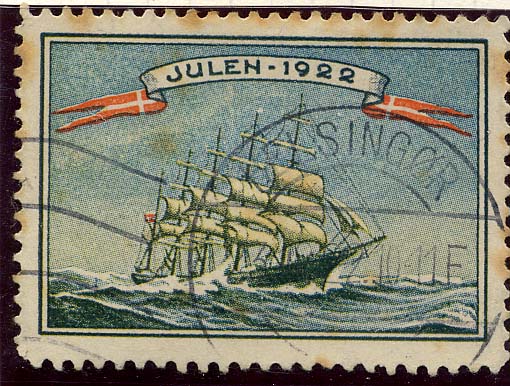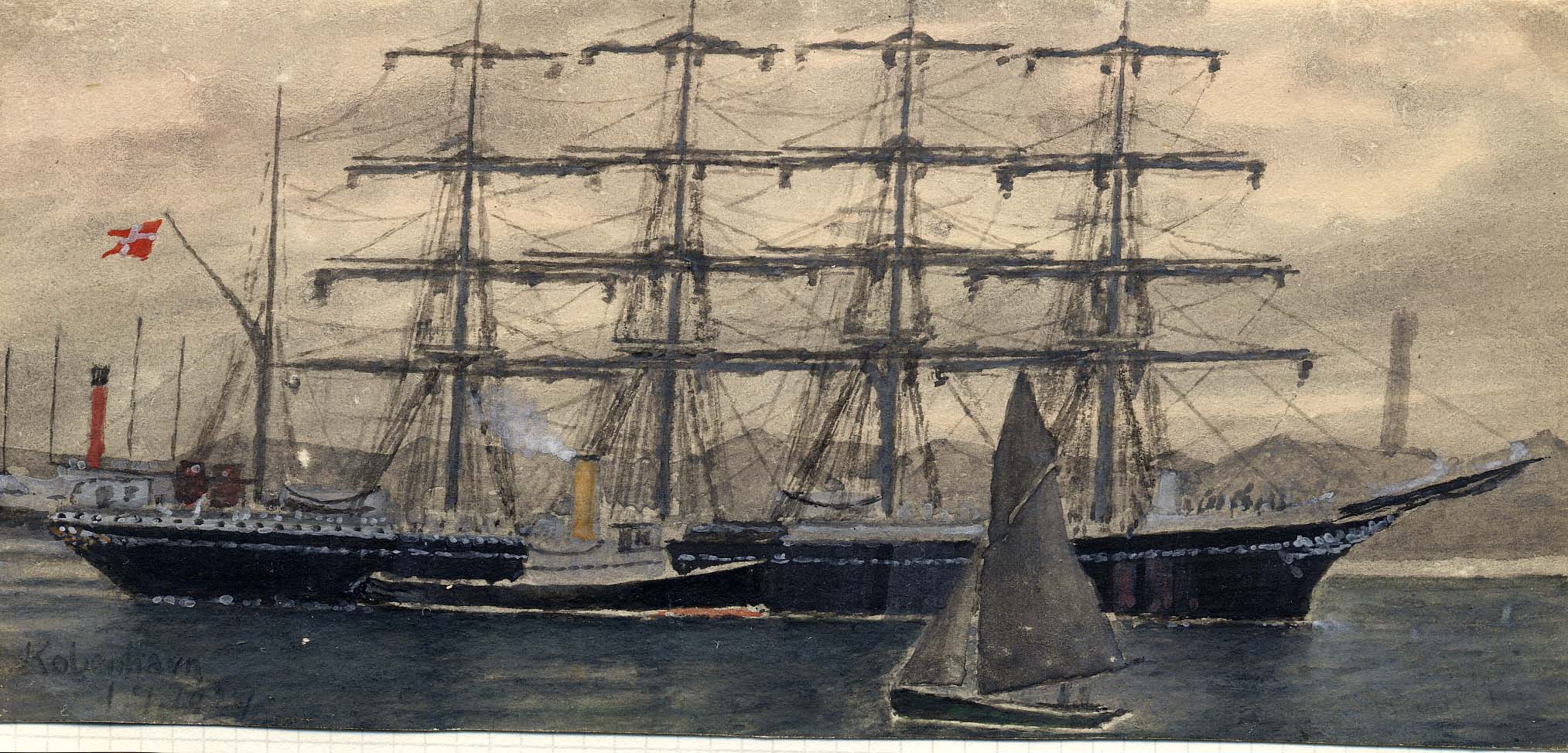Built as a 5-masted barque rigged steel hulled sailing ship under yard No 242 by Ramage & Ferguson, Leith for the A/S Det Ostasiatiske Kompagni, Copenhagen, Denmark.
24 March 1921 launched as the KØBENHAVN, it was already the second ship launched under that name. The first KØBENHAGEN ordered in 1913 by the A/S Det Ostasiatiske Kompagni was requisitioned on the stocks in 1914 by the British Government and completed as an oil storage hulk for the British Navy and renamed BLACK DRAGON. Towed to Gibraltar. In September 1922 sold and renamed in DRAGON.
http://www.historicalrfa.org/rfa-black- ... ip-details
Details of the second KØBENHAVN.
Tonnage 3,965 gross, 3,329 net, dim. 130 x 15.0 x 8.20m., length bpp. 112.44m
One 4-cyl auxiliary diesel engine of 91 nhp. Bunker capacity 204 ton oil.
Cargo capacity for 250,310 cubic feet bale or 288,510 cubic feet grain
Crew 26 and 45 cadets.
September 1921 completed.
KØBENHAVN was a Danish five-masted barque used as a naval training vessel until its disappearance after December 22, 1928. Built for the Danish East Asiatic Company in 1921, it was the world's largest sailing ship at the time, and primarily served for sail training of young cadets.
The KØBENHAVN was last heard from on December 21, 1928 while en route from Buenos Aires to Australia. When it became clear the ship was missing, a lengthy search ensued, but turned up no trace. The disappearance has become one of the greatest maritime mysteries of the modern era, and led to much speculation about the ship's ultimate fate.
Description
The KØBENHAVN was built by the firm of Ramage and Ferguson at Leith in Scotland (number 256), begun in 1920/21, launched March 24, 1921. It was constructed for the Danish East Asiatic Company as a sail training ship. Known as the "Big Dane", it was the largest sailing ship in the world when completed. It was 430 feet (131 metres) long and grossed 3,965 tons; its five masts stood nearly 20 stories high with sails spanning a total of 56,000 square feet (5,202 square metres). It had an auxiliary diesel motor as well as a wireless transmitter. The figurehead was a carving of a helmeted Bishop Absalon.
Primarily intended for training young cadets seeking an officer's license, the ship offset some of its costs by carrying limited amounts of cargo on its voyages. Baron Nils Juel-Brockdorff oversaw the ship's construction and subsequently served as its first captain. From 1921 to 1928 the ship made nine voyages, visiting nearly every continent and completing two circumnavigations.
Disappearance
On September 21, 1928, the KØBENHAVN departed from Nørresundby in Northern Jutland for Buenos Aires on its tenth, and ultimately final, voyage. The captain was Hans Andersen; 75 persons were aboard, including 26 crew and 45 cadets. The goal was to unload a shipload of chalk and bagged cement in Buenos Aires, take on another load of cargo and sail for Melbourne, and then bring a shipment of Australian wheat back to Europe.
The KØBENHAVN arrived at Buenos Aires on November 17, 1928, impressing the locals, in particular emigrant Danes. The cargo was unloaded, however departure was delayed as there were no paying commissions to take cargo to Australia. Finally, on December 14, Captain Andersen decided to ship out for Australia without a cargo. The voyage was expected to take 45 days. On December 22 the KØBENHAVN exchanged radio messages with the Norwegian steamer WILLIAM BLUMER, indicating they were about 900 miles from Tristan da Cunha and that "all is well". The BLUMER attempted to contact the KØBENHAVN again later that night, to no avail. The ship was never heard from again.
Search and legacy
Due to the length of the voyage to Australia, and the fact that Andersen routinely went long periods without sending a message, the Danish were not initially worried. However, concern mounted as months passed without word. In April 1929 the Danish East Asiatic Company dispatched a motor vessel, the MEXICO, to Tristan da Cunha. Residents reported having seen a large five-masted ship with its foremast broken on January 21, 1929; however it had not attempted to land on the island. The MEXICO, joined by the British Royal Navy, searched for the KØBENHAVN for several months, but found no sign of it. The Danish government officially declared the ship and its crew were lost at sea.
A number of theories for the KØBENHAVN’s disappearance have been advanced. The most commonly accepted is that the ship struck an iceberg in the dark or fog. If so, the ship may have sunk too quickly for the crew to react. The lack of wreckage found later may have been the result of the ship's particularly secure loading and rigging, a necessity against the strong winds known as the Roaring Forties. An alternate theory is that the ship, which was in ballast with no cargo, may have been capsized by heavy winds, disabling the lifeboats for survivors.
For the next two years after the KØBENHAVN’s disappearance there were a number of sightings of a mysterious five-masted ship fitting its description in the Pacific, fueling further speculation about the vessel. Early reports came from Chilean fishermen, then in July 1930, the crew of an Argentine freighter sighted a five-masted "phantom ship" during a gale. The captain took their statements and wondered if this was the "wraith of the Copenhagen". Further sightings came in the following weeks from Easter Island and the Peruvian coast. Later some wreckage, including a piece of stern bearing the name "KØBENHAVN , reportedly was found off West Australia.
Tentative evidence for the ship continued to emerge. In 1934 The New York Times reported that a KØBENHAVN cadet's diary had been found in a bottle on Bouvet Island in the South Atlantic. The supposed diary indicated that the ship had been destroyed by icebergs and abandoned, the crew taking their chances in lifeboats. In 1935, human remains and the remains of a lifeboat were found partly buried in the sand along the southwest coast of Africa. These may have come from KØBENHAVN.
In 2012, divers found a wreck off the south west coast of Tristan da Cunha. The wreck has not yet been identified. The island's authorities are working with the Danish Maritime Museum, the Danish Ministry of Foreign Affairs and the Danish East Asiatic Company to work out if this is the KØBENHAVN.
2015 Till so far the wreck at Tristan is not identified as the KØBENHAVN.
Tristan da Cunha 1988 50p sg460, scott?
Danmark 2015 7kr sg?, scott?
https://en.wikipedia.org/wiki/K%C3%B8benhavn_(ship)

